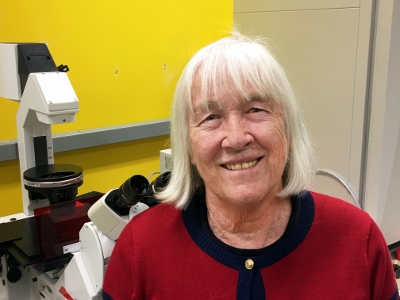
U of A researcher Jean Vance recognized with international Wilhelm Bernhard lifetime achievement award.
When University of Alberta biochemist Jean Vance first isolated and named mitochondria-associated membranes (MAM) in 1990, nothing was known about the function of these membranes in cells. Decades later, MAMs have inspired a field of study that some believe could eventually transform diagnosis and treatment of prevalent diseases such as cancer, diabetes, Parkinson's and Alzheimer's.
"If you don't have good mitochondrial function, you're dead," Vance said. "From electron microscopy scientists had previously revealed that mitochondrial membranes appeared to be very close to other cellular membranes, but they had no idea that these close contacts had a purpose. We demonstrated for the first time that MAMs enabled direct communication between mitochondria and other membranes in the cell, and today this research field is enormous."
Mitochondria have long been recognized as the 'powerhouses' of the cell, producing energy for functioning of cells and the human body. However, how their activity is controlled had long remained a mystery. The membranes that Vance identified are responsible for moving vital materials into and out of the mitochondria, a crucial process for mitochondrial activity and, hence, cell survival.
Vance was an Assistant Professor of Medicine and member of the Lipid Group when she conducted experiments leading to this discovery. She was the sole author of the published initial findings in 1990-a remarkable accomplishment by today's standards. She was elected Fellow of the Royal Society of Canada in 2008, and was recently awarded the international Wilhelm Bernhard lifetime achievement award for this fundamental research at the internationalEMBO Workshop on Membrane Contact Sites in Health and Disease in Arosa, Switzerland, where 50 talks and 120 posters were devoted to MAM-related research.
A curiosity-driven discovery broadens research horizons
"Nobody paid much attention to MAM at the time," Vance said. "I didn't do the experiments thinking, oh, this is where I'm going to cure Alzheimer's disease. I was just interested in understanding how cells worked at a basic level. Many years later the fruits of that research are becoming evident." Until 2000, Vance's discovery went largely unnoticed in the scientific community. Nevertheless, with an active interest in the role of cellular function in disease, MAMs have become increasingly important.
"Dr. Vance made one of the most important discoveries in cell biology, and I would argue it is one of the hottest fields in medical research today," said Thomas Simmen, Professor of Cell Biology and member of the Neuroscience and Mental Health Institute (NMHI) and the Cancer Research Institute of Northern Alberta (CRINA). "It has ramifications for neurodegeneration, diabetes and cancer."
Simmen says mitochondria can be compared to nuclear power plants. "They are usually quietly doing their job, always under control of the normal chemistry occurring on MAM. But if things go wrong, MAM can trigger mitochondria to actually explode and release death-causing molecules."
In the normal lifespan of a cell, these destructive MAMs tell mitochondria when a cell is no longer needed thereby triggering cell death. However, Simmen says that this process does not work properly in certain diseases. "By discovering this structure, Vance laid the foundation for fundamental insights into cell regeneration, where cells either do not die when they should in the case of cancer, or die too soon in the case of neurodegeneration. It's been confirmed in the past five years that in both of these situations, the MAM is abnormal."
Vance said that "major advances in understanding specific diseases often come from apparently unrelated fundamental discoveries. The classic example of that is Alexander Fleming who discovered penicillin. He was studying molds, then one day he found that bacteria were killed by the mold, which led to the discovery of penicillin. This story shows how basic science can have huge implications for human health, even though it can take years."
It is still very early, but Simmen suspects the impact of Vance's work will be enormous for the diagnosis and treatment of disease. One key goal for the future will be to determine the status of MAM in living organisms. Although Vance is now semi-retired, she remains curious and still plans to keep an eye on the scientific advances in understanding the roles of MAM.